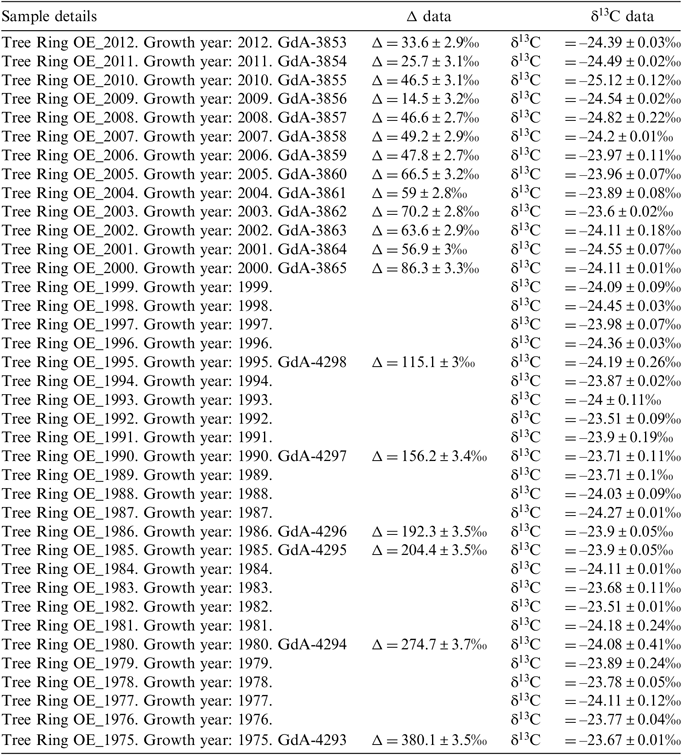INTRODUCTION
We list below 14C and δ13C results of the measurements of the annual rings of Scots pine (Pinus sylvestris L.) from Kędzierzyn-Koźle (50°20′N,18°19′E), Hutki Kanki (50°24′N,19°28′E) near Dąbrowa Górnicza, Podlesie (50°10′N,18°58′E) near Katowice and Olesno (50°48′N,18°23′E), Poland. The Silesian region is a highly populated and industrialized area. The investigated period of time (1975–2012) covers the period of industrial development and implementation of pro-ecological policy in the industrial sector. The three sampling sites: Kędzierzyn-Koźle, Dąbrowa Górnicza, and Podlesie, are located in a highly industrialized area, whereas Olesno is 100 km away from factories. In Kędzierzyn-Koźle there are chemical (nitrogen and petrochemical) factories, whereas near Dąbrowa Górnicza there is a steelworks and coking plant, and Podlesie is located near a combined heat and power plant. The analysis of annual tree-rings of pine (Pinus sylvestris L.) was performed at the Silesian University of Technology in Gliwice. M. Opała and S. Wilczyński provided the samples and their chronology (Sensuła et al. 2015a, 2015b; Sensuła and Wilczyński Reference Sensuła and Wilczyński2018). The dendrochronologically dated annual tree rings were manually separated, pooled, homogenized, and cut into small pieces. α-cellulose samples were extracted (from 10 trees per site) by applying procedures based on Green’s method (Reference Green and Whistler1963) used in the mass spectrometry laboratory of the Silesian University of Technology (Sensuła and Wilczyński Reference Sensuła and Wilczyński2017).The stable isotopic compositions of annual tree rings were analyzed with annual resolution for the period 1975–2012. The 14C isotopic compositions of annual tree rings α-cellulose were analyzed by AMS with annual resolution for the period 2000–2012 and for each 5th year resolution for the period 1975–2000 (Sensuła et al. Reference Sensuła, Michczyński, Piotrowska and Wilczyński2018; Sensuła and Wilczyński Reference Sensuła and Wilczyński2018).
Samples of α-cellulose were converted to graphite for AMS 14C measurements (Piotrowska Reference Piotrowska2013; Sensuła et al. Reference Sensuła, Michczyński, Piotrowska and Wilczyński2018). The process was performed using an AGE automated graphitization system (Wacker et al. Reference Wacker, Nemec and Bourquin2010). Oxalic Acid II (NIST SRM4990C) was used as a reference material. 14C concentrations were determined at the DirectAMS laboratory, Bothell, WA, USA (Zoppi et al. Reference Zoppi2010). Three to four graphites of blank and OxII were measured in the same run as unknown α-cellulose samples. The average blank for these series was 0.3 pMC, which corresponds to 46.6 ka BP, and this value was subtracted from measured concentrations. δ13C were determined using an Isoprime continuous flow isotope ratio mass spectrometer (GV Instruments, Manchester, UK) at the mass spectrometry laboratory of the Silesian University of Technology.
ACKNOWLEDGMENTS
The authors wish to express their sincere gratitude to everyone who contributed to making these investigations possible, particularly Magdalena Opała and the technical staff of Silesian University of Technology, who helped in the sample collection and technical work. This work was supported by National Science Center, Poland [grant number DEC–2011/03/D/ST10/05251]; the Ministry of Science and Higher Education [grant number BKM-507/RIF/2013, BKM-509/RIF/2014 and BKM-513/RIF/2015]; the rector’s grant in the area of research and development, Silesian University of Technology [grant number 14/990/RGJ19/0117].
APPENDIX
Table 1 Tree-ring samples collected near Kędzierzyn-Koźle (50°20′N,18°19′E), from Pinus sylvestris L. (Sensuła et al. Reference Sensuła, Michczyński, Piotrowska and Wilczyński2018).

Table 2 Tree-ring samples collected near Hutki Kanki (50°24′N,19°28′E) near Dąbrowa Górnicza from Pinus sylvestris L. (Sensuła et al. Reference Sensuła, Michczyński, Piotrowska and Wilczyński2018).

Table 3 Tree-ring samples collected near Podlesie (50°10′N,18°58′E) near Katowice from Pinus sylvestris L. (Sensuła et al. Reference Sensuła, Michczyński, Piotrowska and Wilczyński2018).

Table 4 Tree-ring samples collected near Olesno (50°48′N,18°23′E) from Pinus sylvestris L.







